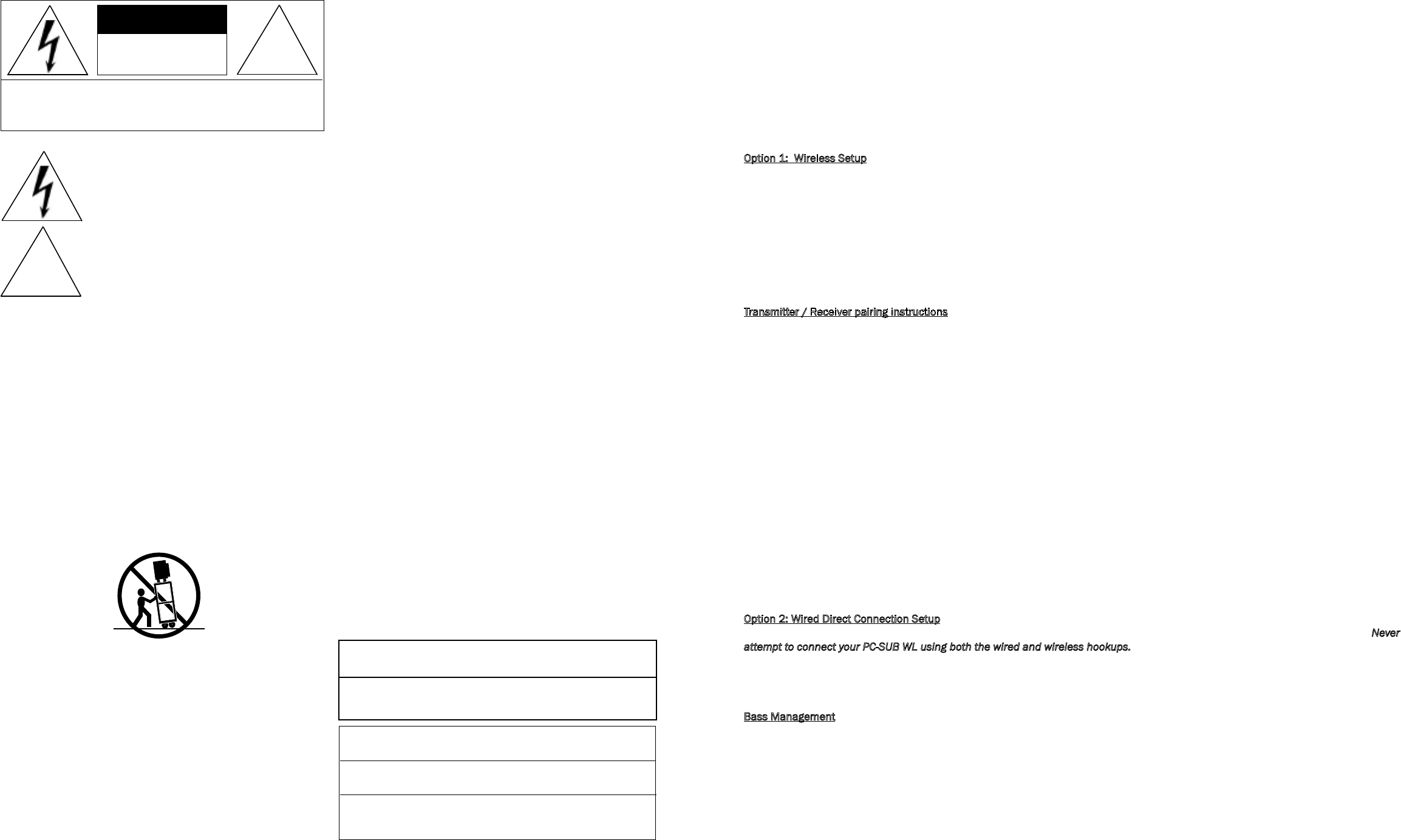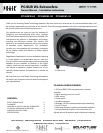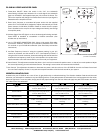
1. Read Instructions - All the safety and operating
instructions should be read before the appliance is operated.
2. Retain Instructions - The safety and operating
instructions should be retained for future reference.
3. Heed Warnings - All warnings on the appliance and in the
operating instructions should be adhered to.
4. Follow Instructions - All operating and other instructions
should be followed.
5. Water and Moisture - The appliance should not be used
near water - for example, near a bathtub, washbowl, kitchen
sink, laundry tub, in a wet basement, or near a swimming pool,
etc.
6. Carts and Stands - The appliance should be used only
with a cart or stand that is recommended by the manufacturer.
PORTABLE CART WARNING
7. Wall or Ceiling Mounting - The appliance should be
mounted to a wall or ceiling only as recommended by the
manufacturer.
8. Ventilation - The appliance should be situated so that
its location or position does not interfere with its proper
ventilation. For example, the appliance should not be situated
on a bed, sofa, rug, or similar surface that may block the
ventilation openings; or placed in a built-in installation, such as
a bookcase or cabinet that may impede the ow of air through
the ventilation openings.
9. Heat - The appliance should be situated away from heat
sources such as radiators, stoves, or other appliances that
produce heat.
PLACEMENT
Subwoofers offer the greatest variety of placement options since very low frequencies are essentially non-directional. That is, the human
ear cannot determine where low frequencies originate, thus, speaker placement is open to a wide variety of choices. By using the
wireless option, your PC-SUB WL subwoofer can be placed anywhere AC power is available within a 50-foot radius of the transmitter. It is
recommended that you place the subwoofer along the same wall as your front speakers. If using one subwoofer, a corner placement will
give you the most low frequency output. If using two subwoofers, start by placing them next to the front left and right speakers in both
front corners or one in the corner and one 1/3 of the way along the front wall from the corner. Each room is different. Experiment with
these options and try other locations until you get the best results.
HOOKING UP YOUR PC-SUB WL SUBWOOFER
Option 1: Wireless Setup
The PC-SUB WL wireless transmitter includes a power adapter. This power adapter is a universal adapter and is designed to operate on
household power of 100-240V and 50/60Hz. Plug the power adapter into a convenient power outlet and the small coaxial power plug
into the rear of the transmitter socket labeled “DC In +5V”. The transmitter should power up and display a blue LED light on the front of
the unit.
Next, connect the “SUB/Left IN” on the wireless transmitter to the “Subwoofer Out”, “SUB OUT”, or “Pre-Amp Out” connection on the
rear of your receiver or processor using a dedicated RCA interconnect cable. Plug the PC-SUB WL into a wall outlet and turn the power
switch on. The power LED should turn red and the Wireless Status LED should be blue. The transmitter and the subwoofer now need to
be synchronized (paired) so that they will recognize each other.
Transmitter / Receiver pairing instructions
Up to two PC-SUB WL Subwoofer systems can work in close proximity. When using two subwoofers each needs to be paired to its own
transmitter. Pairing is done as follows:
1. Press the RESET button for the receiver unit on the back of the subwoofer once. The blue LED will start blinking quickly.
2. Press the button located on the bottom of the transmitter unit once. The Blue LED will start blinking quickly. After a few seconds both
blue LEDs will stay on continuously. If pairing is not successful the blue LED on the Transmitter will start blinking slowly after 10 seconds.
In this case, press the button on the transmitter again.
Note: There is no need to press the receiver button again (the button on the back of the subwoofer). The ashing Receiver LED indicates
that the receiver is waiting for a transmitter to connect to it.
Two wireless PC-SUB WL subwoofers can be used simultaneously, but each requires its own transmitter. If you already have one system
installed, then repeat the above process but press the transmitter button on the second transmitter twice in order to avoid interference
with the rst system. Our wireless topology uses adaptive frequency hopping. If interference is detected the transmitter and receiver
automatically switch to another channel. If for some reason the pairing is interrupted then re-pairing will resolve the problem and return
the system to normal operation.
NOTE: Recommended wireless operating range is 50 feet. The range depends on usage and obstructions between the transmitter and
receiver.
Option 2: Wired Direct Connection Setup
This is the recommended (wired) method of connection for those applications where the Wireless Transmitter will not be used.
Never
attempt to connect your PC-SUB WL using both the wired and wireless hookups.
Most A/V receivers and processors are equipped with a “Subwoofer Out” or “Pre-Amp Out” connection. Run a dedicated RCA interconnect
cable from the “SUB OUT” terminal on your receiver or amplier to the “LINE IN” terminal on the subwoofer.
Bass Management
Many home theater receivers/processors have a “Bass Management” feature that controls how the bass is processed and delivered to
the subwoofers. Look carefully in your amplier or receiver’s instruction manual for details on how to adjust this feature for your system.
When used with a Dolby Digital or DTS-capable receiver/processor with the transmitter or subwoofer hooked to the sub out turn the “LOW-
PASS FREQUENCY” control to the “LFE” setting on the back of your subwoofer.
If you are NOT using the receiver’s internal processor for subwoofer control then turn the “LOW-PASS FREQUENCY” control on the PC-SUB
WL to the desired setting. Consult the instruction manuals for your amplier/receiver and speaker system for their recommended setting.
It may take some experimentation to nd the best sound for your room and your system.
SAFETY INSTRUCTIONS
10. Power Source - The appliance should be connected
to a power supply only of the type described in the operating
instructions or as marked on the appliance.
11. Power Cord Protection - Power supply cords
should be routed so that they are not likely to be walked
on or pinched by items placed up or against them, paying
particular attention to cords at plugs, convenience
receptacles, and the point where they exit from the
appliance.
12. Cleaning - The appliance should be cleaned only as
recommended by the manufacturer.
13. Nonuse Periods - The power cord of the appliance
should be unplugged from the outlet when left unused for a
long period of time.
14. Object and Liquid Entry - Care should be taken so
that neither objects fall nor liquids spill into the inside of the
appliance.
15. Damage Requiring Service - The application should
be serviced by qualied service personnel when:
a. the power supply cord or the plug has been damaged,
b. Objects have fallen onto or liquid has been spilled into the
appliance,
c. the appliance has been exposed to rain,
d. the appliance does not appear to operate normally or
exhibits a marked change in performance, or
e. the appliance has been dropped or the cabinet damaged.
16. Servicing - The user should not attempt to service the
appliance beyond those means described in the operating
instructions. All other servicing should be referred to qualied
service personnel.
17. Grounding or Polarization - Precautions should be
taken so that the grounding or polarization means of an
appliance is not defeated.
18. FCC Rules Part 15 Compliance - This device
complies with part 15 of the FCC rules. Operation is subject
to the following two conditions:
(1) This device may not cause harmful interference, and
(2) This device must accept any interference received,
including interference that may cause undesired operation.
Changes or modications not expressly approved by the party
responsible for compliance could void the user’s authority to
operate the equipment.
This Class B digital apparatus complies with Canadian ICES-
003.
Cet appareil numérique de la classe A est conforme à la
norme NMB-003 du Canada.
!
Explanation of Graphical Symbols
The lightning ash with arrowhead symbol, within an
equilateral triangle, is intended to alert you to the
presence of un-insulated “dangerous voltage: within the
product’s enclosure that may be of sufcient magnitude
to constitute a risk of electric shock to persons.
The exclamation point within an equilateral triangle
is intended to alert you to the presence of important
operating and maintenance (servicing) instructions in the
literature accompanying the appliance.
CAUTION: To reduce the risk of electric shock, do not remove cover (or
back). No user-serviceable parts inside. Refer servicing to qualied service
personnel.
CAUTION
RISK OF ELECTRIC SHOCK
DO NOT OPEN
!
APPLICABLE FOR USA, CANADA OR WHERE APPROVED
FOR USAGE
CAUTION: TO PREVENT ELECTRIC SHOCK, MATCH WIDE BLADE PLUG TO
WIDE SLOT, INSERT FULLY.
ATTENTION: POUR EVITER LES CHOCS ELECTRIQUES, INTRODUIRE LA LAME
LA PLUS LARGE DE LA FICHE DANS LA BORNE CORRESPONDANTE DE LA
PRESE ET POUSSER JUSQU AU FOND.





